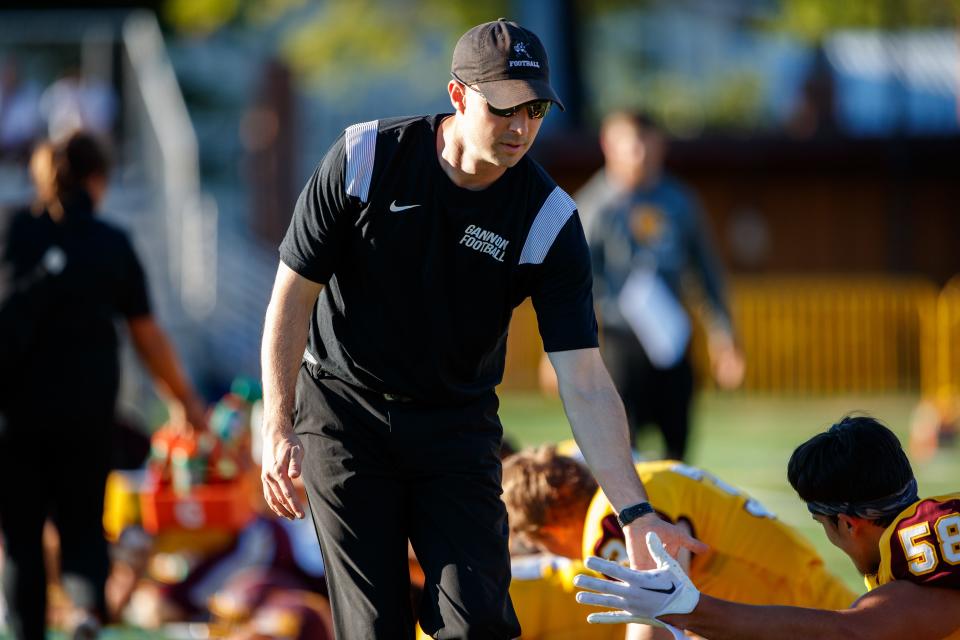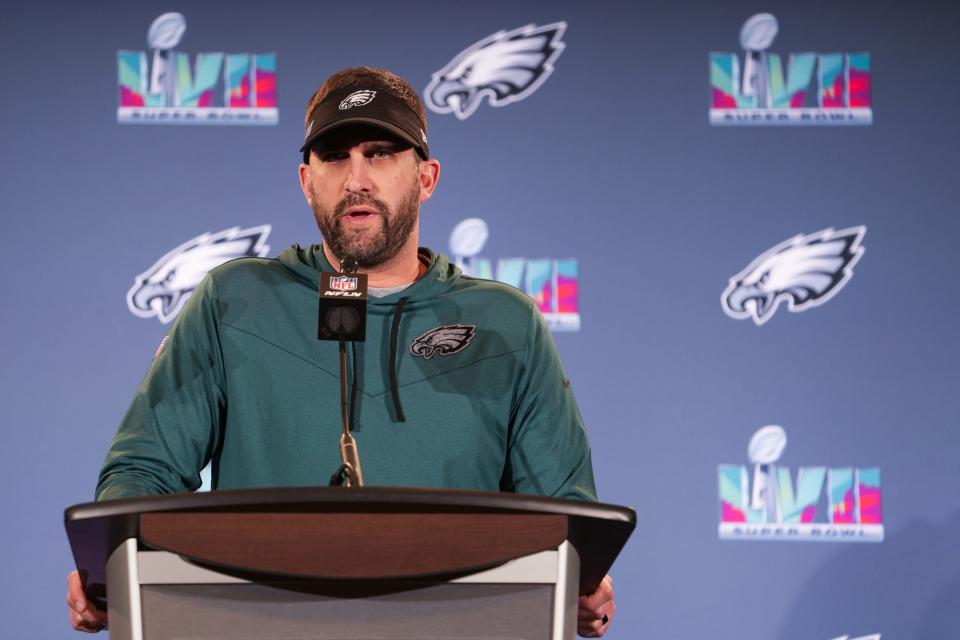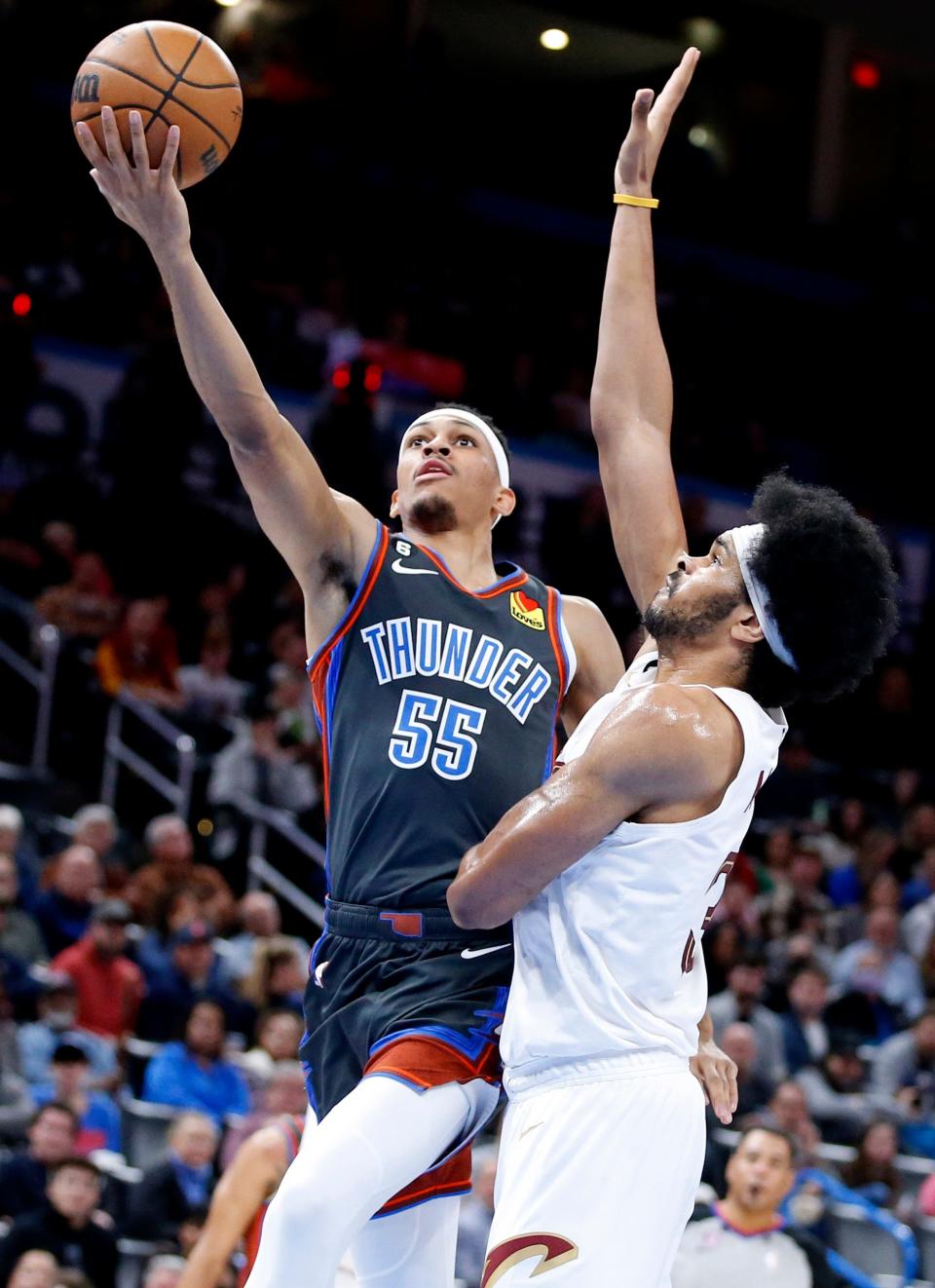Tramel's ScissorTales: OSU's new coaching pipeline also produced Eagles' Nick Sirianni
- Oops!Something went wrong.Please try again later.
- Oops!Something went wrong.Please try again later.
- Oops!Something went wrong.Please try again later.
- Oops!Something went wrong.Please try again later.
- Oops!Something went wrong.Please try again later.
- Oops!Something went wrong.Please try again later.
- Oops!Something went wrong.Please try again later.
- Oops!Something went wrong.Please try again later.
- Oops!Something went wrong.Please try again later.
- Oops!Something went wrong.Please try again later.
Nick Sirianni coaches the Philadelphia Eagles in Super Bowl 57 against the Kansas City Chiefs on Sunday night.
Sirianni got his break into the National Football League at age 27, when then-Chiefs coach Todd Haley hired Sirianni as a quality-control coach in 2009, out of Indiana University of Pennsylvania.
IUP was in the Pennsylvania State Athletic Conference. The same NCAA Division II league that Mike Gundy has made his primary shop for coordinators.
The Friday ScissorTales wonders what went wrong with the Thunder’s Darius Bazley, tries to figure out what will become of OU wrestling and salutes OSU for providing the Super Bowl grass. But we start with a small-college conference in Pennsylvania.
Gundy hired Gannon’s Bryan Nardo as defensive coordinator a couple of weeks ago. Ten years ago, Gundy got offensive coordinator Mike Yurcich from Shippensburg.
The PSAC. Cradle of coaches. Who knew?
More:Oklahoma State AD Chad Weiberg feels early exit of OU, Texas best for all. 'What everyone wanted.'

PSAC commissioner Steve Murray laughed at the notion. Not because it’s not true. But because it’s so cool.
The PSAC, not a powerhouse league even on the Division II level, is making a name for itself, and Gundy is no small factor in that development.
“We’ll be rooting for the Cowboys,” Murray said from his office on the campus of Lock Haven University. “There’s no doubt about it.”
The 16-school PSCA is made up of 15 Pennsylvania schools and West Virginia’s Shepherd University, which sits just across the Penn line.
The Pennsylvania schools are Kutztown, West Chester, Millersville, East Stroudsburg, Shippensburg, Bloomsburg, Lock Haven, IUP, Slippery Rock, Gannon, California-Pennsylvania, Edinboro, Clarion, Seton Hill and Mercyhurst.
“I think we’ve always been what I would call a coach’s league,” Murray said. “We don’t have a lot of turnover at the top spots, and as a result, I think they bring in a lot of guys that they let learn young early and learn a lot on their own.”
Another PSAC alumnus is Curt Cignetti, a (successful) newcomer to Division I-A with James Madison, who coached IUP from 2011-16.
Plus Sirianni.
The PSAC doesn’t have a bunch of money. Division II football scholarships are capped at 36. Murray figures most of his schools give out fewer than 20.
The coaching staffs aren’t big. The head coach usually takes a position, like quarterback or linebacker. Assistant coaches work at a variety of duties.
“So they get a lot of experience early,” Murray said. “That’s kind of what it’s been. A nice training ground, coaches with a lot of experience that aren’t worried about having young bucks on their staff and letting them do their thing.”
More:Tramel: Why Ole Miss, with a returning quarterback, wanted Spencer Sanders

Yurcich was a young buck when hired by Gundy at age 37. Yurcich played at California-Pennsylvania, then coached at Edinboro and Shippensburg before OSU called. Yurcich stayed six years in Stillwater, produced quality offenses and since has been offensive coordinator at Ohio State, Texas and Penn State.
Nardo, 37, has coached at Emporia State, Youngstown State and Gannon.
“It’s a hard-nosed league,” Murray said. “Seventy-five, 80 percent of our rosters are Pennsylvania kids. It’s hard-nosed, it’s brutal football.
“They butt heads. They do not like each other. They don’t like each other from high school. Pretty tough league, pretty tough kids. Our coaches reflect that.”
It’s hard to find the purity in sports anywhere. Purity long ago left the high schools and the youth organizations. But maybe the small-college experience is an outlier.
“For us, our schools, our presidents talk more about graduation rates than they do winning national championships and conference championships,” Murray said.
Murray said PSAC athletes don’t transfer as much as what you see in Division I. They are getting maybe $2,000-$3,000 in scholarship money per year and missing games because chemistry projects are due or they’re on nursing rotations at hospitals.
“That’s what I like about what we do,” Murray said.
More:Which Oklahoma State football signees could contribute immediately or are likely to redshirt?
Thunder fails to develop Darius Bazley
The Thunder traded its elder statesman Thursday.
That would be 22-year-old Darius Bazley, sent to Phoenix for veteran Dario Saric and a second-round draft pick, a move that gives the Suns some payroll relief and lets Bazley escape Mark Daigneault’s doghouse.
And yes, Bazley was OKC’s elder statesman. Acquired on June 20, 2019, draft night, when the Thunder drafted Brandon Clarke for Utah at No. 21, then the Jazz took Bazley at No. 23, and the teams swapped, with the Thunder netting a second-round draft pick.
That was a couple of weeks before the Thunder traded for Shai Gilgeous-Alexander and signed Mike Muscala and Luguentz Dort, the other holdovers from OKC’s last playoff team.
The Bazley draft pick was a good gamble, but Clarke has proven to be the better player, and OKC’s Bazley experience must be deemed a failure. Not a draft bust. Big difference.
Darius Bazley is an NBA player. Not all draft picks are. But Bazley showed flashes as a rookie – he even was in the rotation in a seven-game playoff series against Houston, averaging 18.8 minutes, 6.6 points and 6.7 rebounds a game.
Not bad for a rookie who didn’t play in college.
But Bazley’s role and playing time seemed to slip a little every year, until 2022-23, when Bazley played in just two thirds of the Thunder’s 54 games.
Bazley’s offensive skills had eroded by his fourth year. He was a turnover machine. His 3-point shooting – 34.8 percent as a rookie – had dipped below 30 percent each of the last two years, though he was up to 40 percent this season. Bazley never found the flow of the OKC offense.
The Thunder’s catch-and-drive, catch-and-pass, catch-and-shoot rhythm hit a thud with Bazley on the court. He was catch-and-think-about-it.
More:Thunder signs Eugene Omoruyi to NBA contract, waives Justin Jackson

But a funny thing. Bazley’s defense became quite interesting over the years. He turned into a legitimate rim protector as a 6-foot-8 forward. And his versatility, able to switch onto much smaller guards and stay in front of them, became invaluable when he was on the court.
A defender like that can help any team, and Bazley could find himself on the court in the playoffs, depending on the Suns’ matchups.
“His switchability, his shot-contesting, his rebounding and athleticism,” Daigneault said couple of weeks ago. “You can’t find that. Not everybody on our roster can do that. It brings tremendous value.
“His offensive (shortcoming) is louder and it’s easier to focus on, but what he does defensively is pretty unique and pretty special.”
Not special enough to keep, though. Bazley never seemed to fit in much with the Thunder, on or perhaps even off the court.
“I think he’s improved there,” Daigneault said two weeks ago. “His starting point on that was different. He didn’t go to college. It’s taken him longer to get to that point. I think he’s to the point now where he’s got a pretty clear standing of what we want him to do. How we need him to play.”
Alas, 15 days later, Bazley was gone.
Saric is a solid player – he was helping the Suns in recent weeks, averaging 8.8 points and 5.4 rebounds in the last 15 games, with seven starts, and shooting 43.8% from 3-point range.
The Thunder figures to keep Saric the rest of this season, and he could help.
But not as much as a fully-engaged Bazley would have helped. Daigneault is right. Bazley’s defense is out of the ordinary.
Yet somehow, on a team not only shy of big-man talent, but facing big-man injuries, Bazley was more out of the rotation than in.
The Thunder’s draft instincts were right back in 2019. There was a ballplayer inside that athletic body. But the Thunder’s development phase — which has produced dazzling results — failed on Bazley. In OKC, Bazley never became the ballplayer he could have been.
More:Tramel: Why neither time, nor money, was right for Thunder to trade for Kevin Durant
OSU grass will be the Super Bowl turf
Oklahoma State University for decades has had an outstanding turf program in its agricultural college. And a product of that program will be on display Sunday in Super Bowl 57.
The Eagles-Chiefs showdown will be played on Tahoma 31 bermudagrass, a turf variety developed by OSU researchers. And OSU turf also was used in the NFL conference championship games on January 29, in Kansas City and Philadelphia.
“Creating a good turf can create a good environment for the safety of athletic players,” said Yanqi Wu, an OSU plant and soil sciences professor and breeder. “Because the players run very quickly, there is a lot of traction on the turf, so the turf needs to be very solid and dense. When players step on it, there needs to be no slipping and no divots. Tahoma 31 has a very good root system, so it holds its surface very well.”
Alas, OSU-developed turf is not used at Boone Pickens Stadium. The Cowboys play on synthetic grass, AstroTurf’s 3D Decade.
And Mike Gundy doesn’t apologize.
Gundy told us back in November his preference for artificial turf.
“I have said that I think this new surface (in Boone Pickens Stadium) is safer than grass,” Gundy said. “Now, I haven't done the studies. I haven't done any research, so don't pin that on me. But we have played on grass surfaces where we've slipped a lot, where guys slip a lot. I have been really concerned about that.
“These new surfaces, even in wet conditions, if you guys watch, you don't see people slip much based on the stuff they use now. I don't know about the NFL. I don't know what's going on there, I just know that to me, this surface that we use is really, really good.”
A couple of other points. Artificial surfaces are a big cost savings, with virtually no maintenance, though of course the initial investment is huge. And the east-west configuration of Boone Pickens Stadium isn’t ideal for morning sunlight on growing grass.
OSU touts Tahoma 31 as adaptable to many locations from coast to coast.
“It interested a few key leaders in the industry over several years, and golf course superintendents and football field managers communicate; they try products and get a feel for them, then they build trust,” said Dennis Martin, OSU Extension and research turfgrass specialist. “Once a high visibility, top-notch stadium that gets a lot of traffic has success with something, things can spread like wildfire. That’s what we’ve seen with Tahoma 31. The grass is performing, and as long as it continues to perform, I think we’ll continue to see it in those facilities.”
Nearly 85% of OSU’s research royalties are rooted in projects from OSU Agriculture. For the fiscal year 2022, royalties from OSU Ag patents accounted for $2.6 million.
The process for the release of a new OSU turfgrass variety is 10 to 15 years and requires extensive greenhouse, lab and field screening as well as a testing process that can include more than 1,000 experimental plants.
More:Oklahoma State wrestling teammates appreciate Reece Witcraft's 'inspiring' sacrifice
Mailbag: OU wrestling
OU’s move to the Southeastern Conference has some asking what will happen to Sooner wrestling.
Tim: “Quo vadis for OU wrestling after the Big 12? This has been a concern amongst my OU classmates of ‘68 for sometime. The reality is now and still no answer? It just seems strange that lack of wrestling in SEC is obvious, yet there don’t seem to be any discussions how to fix it.”
Tramel: Quo vadis is Latin for “where are you marching?” I looked it up. Sort of cool.
Anyway, 1968. That’s about right in terms of wrestling interest at OU. Been downhill since then. And that was 55 years ago.
OU's got a thousand more important priorities than wrestling. Literally.
I don't know what the future holds for Sooner wrestling. But Missouri wrestles (quite well), so it doesn't have to be a death sentence for the Sooners.
Missouri wrestling returned to the Big 12 in 2022 and won the conference title. The Tigers competed in Mid-American Conference wrestling for a decade after leaving the Big 12 in 2012.
I don’t know if the Big 12 would allow OU wrestling to remain as an affiliate member. Big 12 wrestling now consists of OSU, OU, Iowa State, West Virginia, Missouri, California Baptist, Northern Iowa, Northern Colorado, North Dakota State, South Dakota State, Utah Valley, Air Force and Wyoming.
Nothing has to change for OU wrestling. But the Big 12 could want to be rid of the Sooners and force OU wrestling to seek a home elsewhere.
Stay tuned.
More:OU women's tennis coach Audra Cohen on Sooners' return to ITA indoors & more
The List: NBA title odds
The blockbluster NBA trades this week – Kevin Durant to the Suns, Kyrie Irving to the Mavericks, Russell Westbrook out of the Lakers – has rearranged the Western Conference playoff possibilities.
Here are the latest championship odds, according to Sports Betting.
1. Boston 7-2: Winning the Eastern Conference just got easier, with Brooklyn bowing out.
2. Phoenix 9-2: The Suns were 18-1 before acquiring Durant (and T.J. Warren) for Mikal Bridges, Cam Johnson and a draft haul.
3. Milwaukee 23-4: The Bucks are under the radar.
4. Denver 8-1: The Nuggets and Grizzlies were the biggest losers at the deadline, courtesy of Phoenix’s deal.
5. Philadelphia 12-1: Another big winner, as the East thins out.
5. LA Clippers 12-1: The Clips might sign Westbrook, if his contract is bought out by Utah.
7. Mavericks 14-1: Dallas’ hopes have risen.
7. Warriors 14-1: Golden State is built for the playoffs.
9. Grizzlies 18-1: People aren’t quite as bullish on Memphis these days.
10. Cavaliers 22-1: Someone has to be fourth in the Eastern Conference. Can it be Cleveland?
Berry Tramel: Berry can be reached at 405-760-8080 or at btramel@oklahoman.com. He can be heard Monday through Friday from 4:40-5:20 p.m. on The Sports Animal radio network, including FM-98.1. Support his work and that of other Oklahoman journalists by purchasing a digital subscription today.
This article originally appeared on Oklahoman: OSU football, Mike Gundy shop Pennsylvania State Athletic Conference

